
Featured Image Credit: Getty
Topics: Max Verstappen, Red Bull Racing, Formula 1, FIA, Lewis Hamilton

Topics: Max Verstappen, Red Bull Racing, Formula 1, FIA, Lewis Hamilton
Live in constant hope of the top flight as a Preston North End fan. Written in the past for SPORF, GiveMeSport and more.